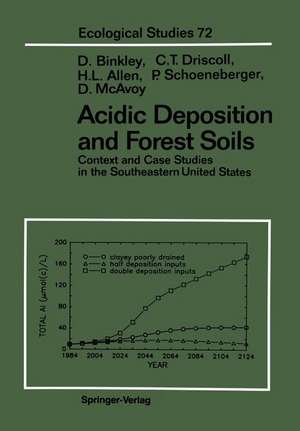Acidic Deposition and Forest Soils: Context and Case Studies of the Southeastern United States: Ecological Studies, cartea 72
Autor Dan Binkley, Charles T. Driscoll, H. Lee Allen, Philip Schoeneberger, Drew McAvoyen Limba Engleză Paperback – 27 sep 2011
Din seria Ecological Studies
- 18%
 Preț: 1118.93 lei
Preț: 1118.93 lei -
 Preț: 553.72 lei
Preț: 553.72 lei - 18%
 Preț: 1680.55 lei
Preț: 1680.55 lei - 18%
 Preț: 1003.38 lei
Preț: 1003.38 lei - 20%
 Preț: 1004.71 lei
Preț: 1004.71 lei -
 Preț: 480.62 lei
Preț: 480.62 lei - 5%
 Preț: 752.26 lei
Preț: 752.26 lei - 15%
 Preț: 643.99 lei
Preț: 643.99 lei - 15%
 Preț: 644.18 lei
Preț: 644.18 lei - 15%
 Preț: 652.49 lei
Preț: 652.49 lei - 18%
 Preț: 789.83 lei
Preț: 789.83 lei -
 Preț: 382.36 lei
Preț: 382.36 lei - 15%
 Preț: 643.48 lei
Preț: 643.48 lei - 15%
 Preț: 646.30 lei
Preț: 646.30 lei - 15%
 Preț: 634.32 lei
Preț: 634.32 lei -
 Preț: 384.86 lei
Preț: 384.86 lei - 18%
 Preț: 789.98 lei
Preț: 789.98 lei - 15%
 Preț: 645.14 lei
Preț: 645.14 lei - 15%
 Preț: 649.39 lei
Preț: 649.39 lei - 18%
 Preț: 1005.43 lei
Preț: 1005.43 lei - 18%
 Preț: 949.23 lei
Preț: 949.23 lei - 15%
 Preț: 649.54 lei
Preț: 649.54 lei - 15%
 Preț: 643.34 lei
Preț: 643.34 lei - 15%
 Preț: 649.71 lei
Preț: 649.71 lei - 15%
 Preț: 638.76 lei
Preț: 638.76 lei - 18%
 Preț: 957.62 lei
Preț: 957.62 lei - 18%
 Preț: 1235.25 lei
Preț: 1235.25 lei - 18%
 Preț: 962.18 lei
Preț: 962.18 lei - 18%
 Preț: 949.23 lei
Preț: 949.23 lei - 15%
 Preț: 660.68 lei
Preț: 660.68 lei -
 Preț: 397.76 lei
Preț: 397.76 lei - 15%
 Preț: 638.24 lei
Preț: 638.24 lei - 18%
 Preț: 942.31 lei
Preț: 942.31 lei - 18%
 Preț: 1232.57 lei
Preț: 1232.57 lei - 15%
 Preț: 651.34 lei
Preț: 651.34 lei - 18%
 Preț: 952.72 lei
Preț: 952.72 lei - 18%
 Preț: 1834.27 lei
Preț: 1834.27 lei - 18%
 Preț: 1229.10 lei
Preț: 1229.10 lei -
 Preț: 423.95 lei
Preț: 423.95 lei - 18%
 Preț: 948.92 lei
Preț: 948.92 lei
Preț: 634.82 lei
Preț vechi: 746.84 lei
-15% Nou
Puncte Express: 952
Preț estimativ în valută:
121.47€ • 127.28$ • 100.42£
121.47€ • 127.28$ • 100.42£
Carte tipărită la comandă
Livrare economică 12-26 aprilie
Preluare comenzi: 021 569.72.76
Specificații
ISBN-13: 9781461281672
ISBN-10: 1461281679
Pagini: 160
Ilustrații: VIII, 149 p.
Dimensiuni: 170 x 244 x 8 mm
Greutate: 0.26 kg
Ediția:Softcover reprint of the original 1st ed. 1989
Editura: Springer
Colecția Springer
Seria Ecological Studies
Locul publicării:New York, NY, United States
ISBN-10: 1461281679
Pagini: 160
Ilustrații: VIII, 149 p.
Dimensiuni: 170 x 244 x 8 mm
Greutate: 0.26 kg
Ediția:Softcover reprint of the original 1st ed. 1989
Editura: Springer
Colecția Springer
Seria Ecological Studies
Locul publicării:New York, NY, United States
Public țintă
ResearchCuprins
1. Introduction.- Purpose of the assessment.- Structure of the assessment.- Background on why this has become an important topic.- Lakes versus forests.- Concerns over effects on forests.- Pathways of acidic deposition impacts.- The uncertain nature of truth in ecosystem studies.- 2. The nature of soil acidity and H+ budgets.- Weak acid behavior of soils.- Changes in soil acidity involving the dynamics of weak and strong acids.- Sulfur, nitrogen and H+ budgets.- Loblolly pine case studies.- 3. Magnitudes and patterns of nitrogen and sulfur deposition in the South.- Sources of acids in the atmosphere.- Anthropogenic emissions of sulfur and nitrogen.- Modes of deposition.- Atmospheric deposition in the South.- Trends in deposition rates.- 4. Forest soils of the South.- Climate.- Regional geomorphology and soils.- Coastal Plain.- Mississippi River Valley.- Piedmont.- Blue Ridge.- Ridge and Valley.- Appalachian Plateaus.- Interior Low Plateau.- Ouachita Uplands.- Ozark Plateau.- Central Lowlands.- Importance in soil acidification.- 5. Previous evaluations of sensitivity of southern soils.- Site-specific studies.- Previous regional assessments of soil sensitivity to acidic deposition.- Critique of criteria for gauging soil sensitivity.- 6. Nutrient cycles and nutrient limitations in the South.- The nitrogen cycle.- The sulfur cycle.- The nutrient cation cycles.- Cycles of other elements.- Nutrient limitations on forest growth in the South.- Conclusions.- 7. Simulation of the potential impacts of acidic deposition on forest soils in the South.- The MAGIC model.- Our approach.- Simulation results.- Discussion of simulation results and implications.- Conclusions from simulations.- 8. Synthesis and recommendations.- References.
















